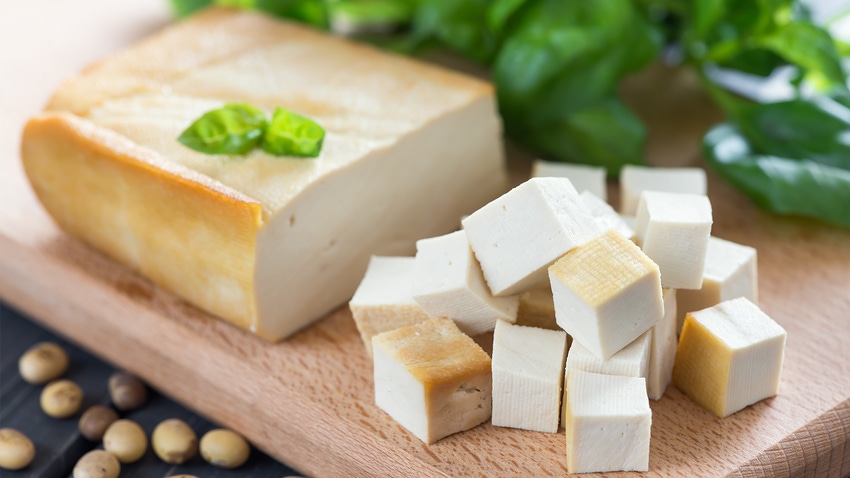Cheesy alternatives adopt AI, fermentation to improve texture, taste
Recent developments in nondairy cheese technology and processing techniques promise to reduce — or eliminate — off flavors and textures caused by traditional ingredients such as nuts and coconut oil.

At a Glance
- Alt-dairy products often use ingredients like nuts, which cost more and can create gritty textures and off flavors.
- Newer products are using AI and fermentation to synthesize creamier, better-tasting, nondairy cheese products.
- The future looks bright for the alt-dairy space, thanks to shifting consumer perceptions and growing market share.
Updated Feb. 23: After writing this article, the author finally had a chance to try Kraft NotMac&Cheese. While undoubtedly creamier and tastier than many plant-based offerings, it still had telltale coconut undertones — and received an enthusiastic thumbs down from his son, a mac and cheese connoisseur who refused to even taste it based on the smell. That said, this hearty take on a classic should make an appealing alternative for vegans and the dairy intolerant.
The server sets down a steaming bowl of mac and cheese. You take a sniff. Smells good. Like mac and cheese should. You grab a fork and scoop up the first glorious mouthful — only to immediately realize this savory, saucy dish contains no actual cheese.
The question, “Is it cheese?” once had an obvious answer. All you had to do was taste the product to figure out something was off. New offerings like Kraft’s NotMac&Cheese, however, prove that times are changing.
The result of a joint venture between The Kraft Heinz Co. and TheNotCompany, or NotCo, this mac and “cheese” combines various plants using a proprietary artificial intelligence (AI) algorithm to recreate the flavors and textures of animal products, supposedly reducing the ecological impact of traditional dairy along with the off flavors of most dairy alternatives.
The growing nondairy market
Countless brands have jumped on the alt-dairy trend, and it’s easy to see why. According to research by The Good Food Institute (GFI) and Plant Based Foods Association (PBFA) based on retail data from SPINS, the U.S. plant-based food market was worth $8 billion in 2022.
Many consumers, however, still have reservations. The Kraft Heinz Co. revealed in its NotMac&Cheese press release that although plant-based foods are a growing category, less than 30% of plant-based mac and cheese buyers made a repeat purchase last year. In the SPINS data, around half of buyers reported that they wouldn’t try an alt-dairy product — or buy it again — because of the texture and taste.
Yet, some companies are breaking down boundaries to improve the experience. They’re experimenting with various types of dairy alternatives, combining novel technologies with natural processes to replicate the distinctive, decadent taste of products made using animal milk.
Innovations in flavor, mouthfeel, more
Most producers of alternative cheese products strive to replicate the soft creaminess and meltable stretchiness of the real deal. Sarah Fitzgerald, a culinologist at CuliNEX, explained the basics of how these products are made and why so many contain off flavors and textures.
“Let’s start with ingredients that create a creamy texture: fat, oil, fibers and gums,” she said. “Secondly, what stabilizes a creamy texture: emulsifiers, plant proteins and process technology. With [growing] consumer acceptance of these ingredients, companies can explore and experiment to create the level of creaminess desired for products such as ice cream, whipping cream, cooking cream, milk and butters.
“It can be challenging to fully incorporate ingredients or remove grittiness or keep the product stable when making a plant-based product,” Fitzgerald explained. “There have been a lot of creative solutions on the processing side that have unlocked great products … Companies are developing great products because they are seeking out great science from internal and external sources. Investment in external partnerships as well as internal experimentation has helped plant-based innovation grow rapidly over the last 10 years.”
What she said makes sense; The Kraft Heinz Co. did team up with NotCo, after all, and innovations like these are driving the industry toward better-tasting products. Fermentation is another exciting arena — one where food developers are finding new uses for old science.
Fermenting “dairy”
Bolder Foods, a Belgium-based food tech startup, has been generating serious buzz with its new B2B product, MycoVeg, a natural bulking agent that enables the creation of creamy, stretchy cheese alternatives without the use of traditional alt-dairy ingredients.
“Our proposition is to offer a new way of creating cheese alternatives that does not rely on nuts or coconut oil,” Ilana Taub, co-founder and CEO of Bolder Foods, said. “Nut-based cheeses deliver better organoleptic properties than coconut oil-based ones; however, they’re allergens, often hard to scale and more importantly very expensive. Coconut oil works well, as it can have both a liquid and solid state; however, it often comes with a coconut flavor, which many consumers dislike … there are a lot of innovations around functional proteins, and particularly focusing on recombinant casein for cheese alternatives. We see that MycoVeg can be a cost-efficient, sustainable ‘home’ for these proteins that also enhances cheesy flavors and textures.”
MycoVeg uses mycelium, a root-like fungal structure, and a carefully selected blend of vegetables to power up cheese alternatives via biomass fermentation. Bolder screened tons of combinations before settling on one that provides a taste and texture similar to traditional dairy.
“We believe that biomass fermentation offers untapped potential for dairy applications,” Taub explained. “We use a vegetable substrate and a non-GMO fungi. It’s a simple liquid fermentation process with minimum downstream processing. On top of that, with MycoVeg, we enable the creation of cheese alternatives that don’t require coconut oil, modified starches or gelling agents. Mycelium is also a powerhouse in terms of nutrition, [as well as] being high in fiber and protein.”
The future of nondairy cheese
Biomass fermentation has been around for a long time, most often used to create plant-based meat products. As public perception shifts, however, new opportunities emerge.
“It can only be a positive sign if big brands are entering the dairy-free cheese market,” Taub said. “They see an opportunity, and many believe this is needed to create a sustainable, equitable food system for all. That said, most products brought to market in cheese alternatives have all used the same formulation — namely, a blend of coconut oil and starch, and I find that a bit disappointing … from a business perspective, it’s a great opportunity for us to show that better alternatives are possible and can be done affordably.”
Various factors continue to contribute to the market growth of alt-dairy products. Sarah Fitzgerald believes that better-tasting products offer a method for smaller brands to capitalize on this opportunity. Such products may serve as a gateway to the more equitable and sustainable food system Taub mentioned.
“Growth over the last 10 years has been astronomical as a consumer,” Fitzgerald said. “The joint venture partnership between Kraft and NotCo is a smart pairing, as it takes the best of both: The channels and brand power of Kraft with the AI technology of NotCo … [but] smaller brands need to understand their target audience. What types of food are people wanting, missing or needing? Pick packaging language that is clear, concise and eye catching.
“In plant-based development, we can use a wide array of ingredients to achieve our end goal, and the variety of ingredient choices is overwhelming,” she explained. “Lean on your ingredient suppliers to help choose the best ingredient/blend for your work with the most stable supply chain. The plant-based consumer is a curious and explorative buyer, as they have needed to be throughout the last few decades. They’re open to trying a new product, but it must be great … we believe taste is everything.”
About the Author(s)
You May Also Like






